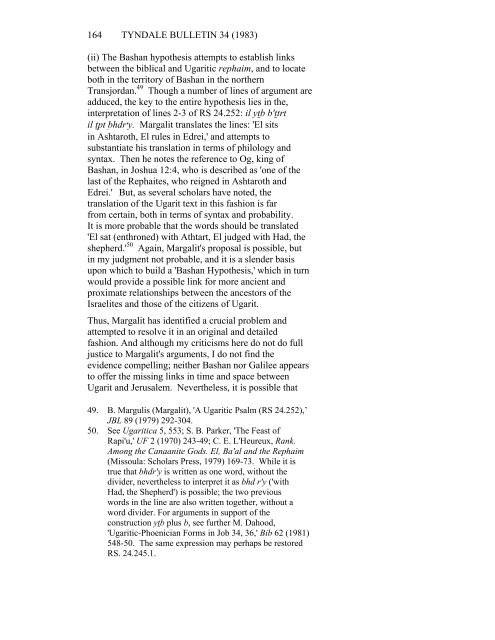UGARIT, CANAAN, AND ISRAEL.pdf - Tyndale House
UGARIT, CANAAN, AND ISRAEL.pdf - Tyndale House
UGARIT, CANAAN, AND ISRAEL.pdf - Tyndale House
You also want an ePaper? Increase the reach of your titles
YUMPU automatically turns print PDFs into web optimized ePapers that Google loves.
164 TYNDALE BULLETIN 34 (1983)<br />
(ii) The Bashan hypothesis attempts to establish links<br />
between the biblical and Ugaritic rephaim, and to locate<br />
both in the territory of Bashan in the northern<br />
Transjordan. 49 Though a number of lines of argument are<br />
adduced, the key to the entire hypothesis lies in the,<br />
interpretation of lines 2-3 of RS 24.252: il ytb b'ttrt<br />
il tptִ bhdr׳y. Margalit translates the lines: 'El sits<br />
in Ashtaroth, El rules in Edrei,' and attempts to<br />
substantiate his translation in terms of philology and<br />
syntax. Then he notes the reference to Og, king of<br />
Bashan, in Joshua 12:4, who is described as 'one of the<br />
last of the Rephaites, who reigned in Ashtaroth and<br />
Edrei.' But, as several scholars have noted, the<br />
translation of the Ugarit text in this fashion is far<br />
from certain, both in terms of syntax and probability.<br />
It is more probable that the words should be translated<br />
'El sat (enthroned) with Athtart, El judged with Had, the<br />
shepherd.' 50 Again, Margalit's proposal is possible, but<br />
in my judgment not probable, and it is a slender basis<br />
upon which to build a 'Bashan Hypothesis,' which in turn<br />
would provide a possible link for more ancient and<br />
proximate relationships between the ancestors of the<br />
Israelites and those of the citizens of Ugarit.<br />
Thus, Margalit has identified a crucial problem and<br />
attempted to resolve it in an original and detailed<br />
fashion. And although my criticisms here do not do full<br />
justice to Margalit's arguments, I do not find the<br />
evidence compelling; neither Bashan nor Galilee appears<br />
to offer the missing links in time and space between<br />
Ugarit and Jerusalem. Nevertheless, it is possible that<br />
49. B. Margulis (Margalit), 'A Ugaritic Psalm (RS 24.252),’<br />
JBL 89 (1979) 292-304.<br />
50. See Ugaritica 5, 553; S. B. Parker, 'The Feast of<br />
Rapi'u,' UF 2 (1970) 243-49; C. E. L'Heureux, Rank.<br />
Among the Canaanite Gods. El, Ba'al and the Rephaim<br />
(Missoula: Scholars Press, 1979) 169-73. While it is<br />
true that bhdr'y is written as one word, without the<br />
divider, nevertheless to interpret it as bhd r'y ('with<br />
Had, the Shepherd') is possible; the two previous<br />
words in the line are also written together, without a<br />
word divider. For arguments in support of the<br />
construction ytb plus b, see further M. Dahood,<br />
'Ugaritic-Phoenician Forms in Job 34, 36,' Bib 62 (1981)<br />
548-50. The same expression may perhaps be restored<br />
RS. 24.245.1.
















